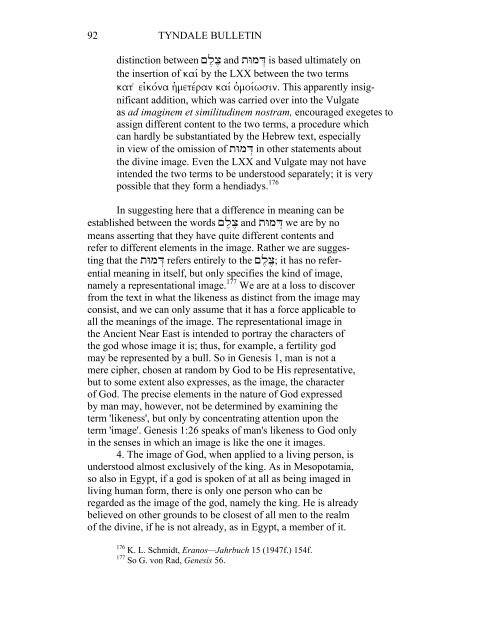THE IMAGE OF GOD IN MAN - Tyndale House
THE IMAGE OF GOD IN MAN - Tyndale House
THE IMAGE OF GOD IN MAN - Tyndale House
- TAGS
- tyndale
- tyndalehouse.com
You also want an ePaper? Increase the reach of your titles
YUMPU automatically turns print PDFs into web optimized ePapers that Google loves.
92 TYNDALE BULLET<strong>IN</strong><br />
distinction between םֶלֶצ and תּ ומּד ְ is based ultimately on<br />
the insertion of καί by the LXX between the two terms<br />
κατ ͗ εἰκόνα ἡμετέραν καί ὁμοίωσιν. This apparently insignificant<br />
addition, which was carried over into the Vulgate<br />
as ad imaginem et similitudinem nostram, encouraged exegetes to<br />
assign different content to the two terms, a procedure which<br />
can hardly be substantiated by the Hebrew text, especially<br />
in view of the omission of תּ ומּד ְ in other statements about<br />
the divine image. Even the LXX and Vulgate may not have<br />
intended the two terms to be understood separately; it is very<br />
possible that they form a hendiadys. 176<br />
In suggesting here that a difference in meaning can be<br />
established between the words םֶלֶצ and תּ ומּד ְ we are by no<br />
means asserting that they have quite different contents and<br />
refer to different elements in the image. Rather we are suggesting<br />
that the תּ ומּד ְ refers entirely to the םֶלֶצ; it has no referential<br />
meaning in itself, but only specifies the kind of image,<br />
namely a representational image. 177 We are at a loss to discover<br />
from the text in what the likeness as distinct from the image may<br />
consist, and we can only assume that it has a force applicable to<br />
all the meanings of the image. The representational image in<br />
the Ancient Near East is intended to portray the characters of<br />
the god whose image it is; thus, for example, a fertility god<br />
may be represented by a bull. So in Genesis 1, man is not a<br />
mere cipher, chosen at random by God to be His representative,<br />
but to some extent also expresses, as the image, the character<br />
of God. The precise elements in the nature of God expressed<br />
by man may, however, not be determined by examining the<br />
term 'likeness', but only by concentrating attention upon the<br />
term 'image'. Genesis 1:26 speaks of man's likeness to God only<br />
in the senses in which an image is like the one it images.<br />
4. The image of God, when applied to a living person, is<br />
understood almost exclusively of the king. As in Mesopotamia,<br />
so also in Egypt, if a god is spoken of at all as being imaged in<br />
living human form, there is only one person who can be<br />
regarded as the image of the god, namely the king. He is already<br />
believed on other grounds to be closest of all men to the realm<br />
of the divine, if he is not already, as in Egypt, a member of it.<br />
176 K. L. Schmidt, Eranos—Jahrbuch 15 (1947f.) 154f.<br />
177 So G. von Rad, Genesis 56.

















